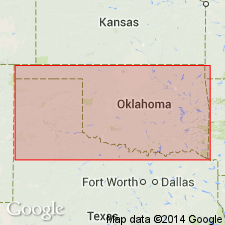
- Usage in publication:
-
- Skiatook formation
- Modifications:
-
- Named
- Dominant lithology:
-
- Shale
- Sandstone
- Limestone
- AAPG geologic province:
-
- Chautauqua platform
Summary:
Named as a formation in the southern area of the Sapulpa group; named for the town of Skiatook, Tulsa Co, OK on the Chautauqua platform. No type locality designated. Occupies a wide zone in northwest part of Tulsa Co; extends southwest across southeast part of Osage Nation to the Arkansas River. This zone is 5 mi wide on the north but widens rapidly southwestward. Consists of shale in the greater part of the formation--about 150 ft thick immediately above the Lenapah limestone (new). In upper part of Skiatook are seen heavy beds of sandstone which thicken enormously from north to south. A limestone lens is best exposed at Lost City on the south side of the Arkansas River 6 mi above Tulsa--reaches 40 ft thick at the quarry. In northwestern part of the Claremore quad, Skiatook is 250-300 ft thick; along Arkansas River, is not less than 500 ft thick. Overlies a bed of dense, massive, bluish limestone, the southern extension of the Lenapah limestone of Sapulpa group; underlies Ramona formation (new) of Sapulpa group. Stratigraphic chart. Of Pennsylvanian age.
Source: GNU records (USGS DDS-6; Denver GNULEX).
For more information, please contact Nancy Stamm, Geologic Names Committee Secretary.
Asterisk (*) indicates published by U.S. Geological Survey authors.
"No current usage" (†) implies that a name has been abandoned or has fallen into disuse. Former usage and, if known, replacement name given in parentheses ( ).
Slash (/) indicates name conflicts with nomenclatural guidelines (CSN, 1933; ACSN, 1961, 1970; NACSN, 1983, 2005, 2021). May be explained within brackets ([ ]).

